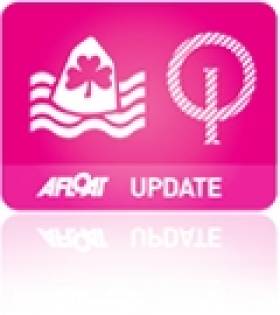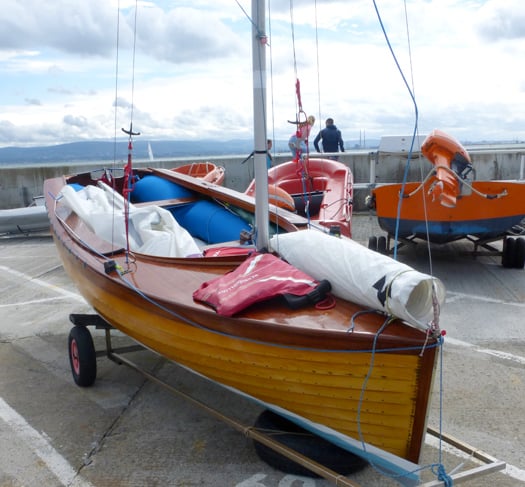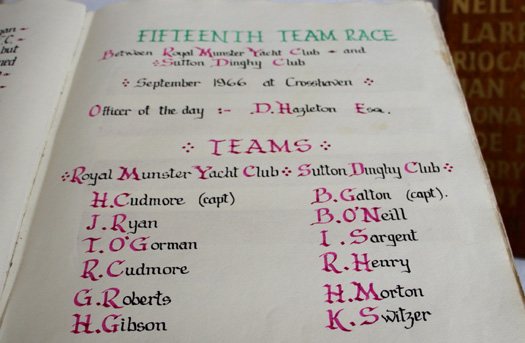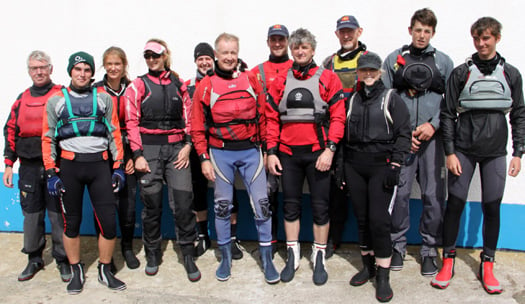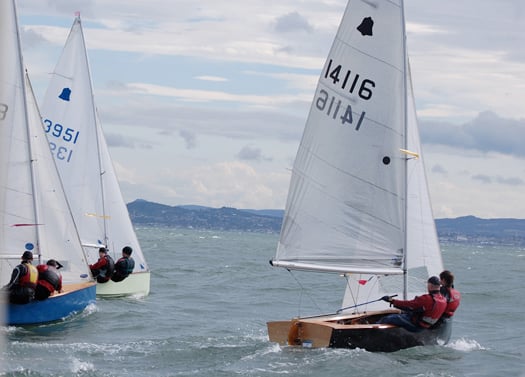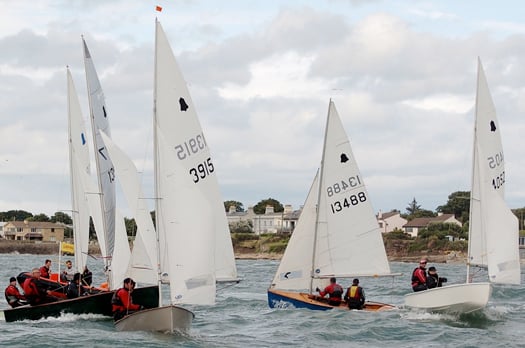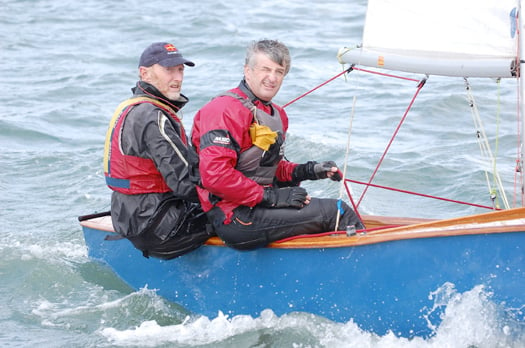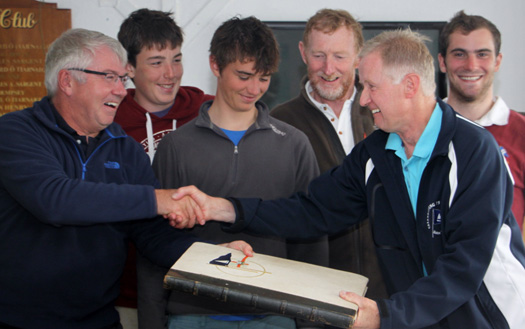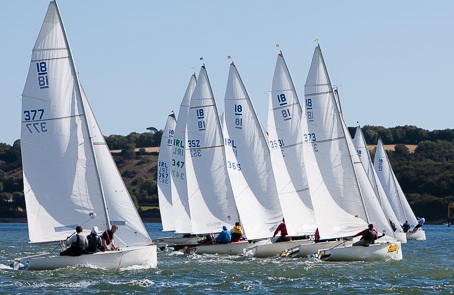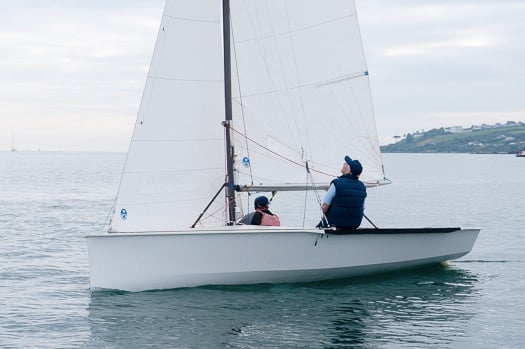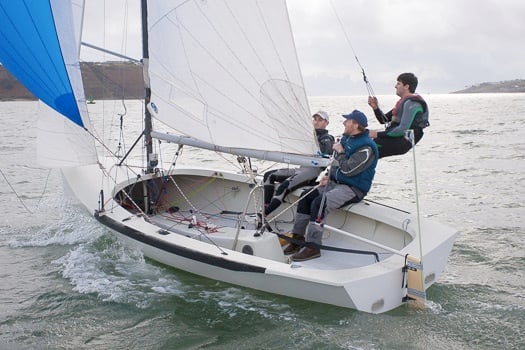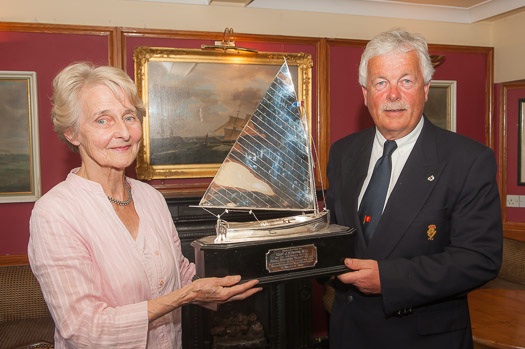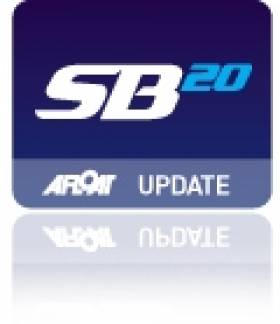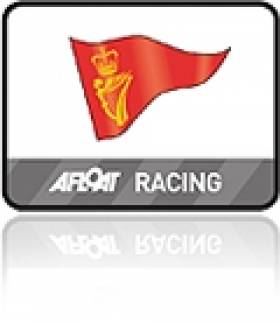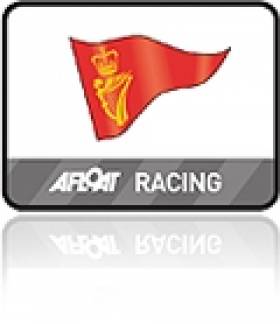Displaying items by tag: RCYC
Royal Cork's McCann Wins Irish Optimist Title, Kinsale's Ó Suilleabhán is Junior Champion
#optimist – Royal Cork's James McCann built on his fine European Optimist performance in Dun Laoghaire a month ago by winning the Irish Optimist dinghy class title on his home waters of Cork Harbour yesterday writes Claire Bateman.
Scroll down for photo gallery of the event below by Bob Bateman.
The wind gods left the best wine for last and it certainly tasted good on the last day of racing at the CH Marine Irish Optimist National and Open Championships wirtes Claire Bateman. The wind was up to about 15 knots most of the time and the sun was shining most of the time. What more could anyone ask! PRO David O'Brien again set the course for the Senior and Junior Fleets on the Eastern Bank and to cater for the north west wind set the committee boat close to the Aghada shore. Two races were sailed for both Senior and Junior fleets and it was all over by 14.30hrs to allow competitors make their way home. However a number of protests were received and the Protest Committee was convened for hearings.
Meanwhile , PRO Eddie Rice's Regatta Fleet again sailed on the Curlane Bank. Not all of the 52 competitors in this fleet sailed today as the conditions were a bit trying for the inexperienced.
The scene after racing had finished was a veritable hive of activity as the competitors, their families and helpers rushed to get away after the prize giving. However, it soon became apparent this was not to be as a protest was going ahead and meant a delay was unavoidable. As many people had ferries to catch and long journeys this meant they could not wait for the prize giving and among these was the new Open Senior Champion Vita Heathcote RIYMYC.
The array of prizes handed out was huge and as the prizes for today were also sponsored by CH Marine Nicholas Bendon MD of the company was there to do the honours in presenting these prizes.
In the Regatta Fleet the overall champion is Moss Simmington RStGYC .
1st Junior Silver Rory O'Sullivan RCYC. 2nd Junior Silver Conor Gorman NYC. 3rd Junior Silver James Hassett RCYC. Best Local Sailor Silver Fleet Sophia McKeown RCYC. Junior Silver First Girl Kate Fahy LDYC/RStGYC.
1stJunior Gold, National and Open Champion.Michael ÓShuilleabháin KYC. Best under 11 and Best Local Sailor Junior Gold Fleet Robert Keal RCYC. Best under 10 Eve McMahon. Best under 9 Trevor Bolger.\
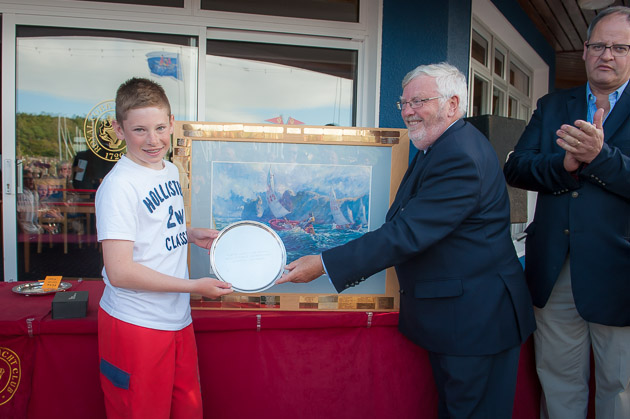
Iriah Senior National Champion James McCann receiving his award from Admiral Pat Lyons
It was then the turn of the Senior Fleet to receive their prizes:
1st Senior Silver Jack Fahy LDYC/RStGYC. 2nd Silver James Spillane RCYC. 3rd Senior Silver Emily Whitaker RCYC.

Vita Heathcote First Senior Gold and Open Champion. Pic Robert Bateman
1st Senior Gold and Open Senior Champion Vita Heathcote RIYMYC. 2nd Senior Gold Emilia BoyleRIYC, 3rd Senior Gold, Irish Senior National Champion and Best Irish sailor at Optimist European Championships James McCann. Senior Gold First Girl and best under 13 Irish Clare Gorman NYC.
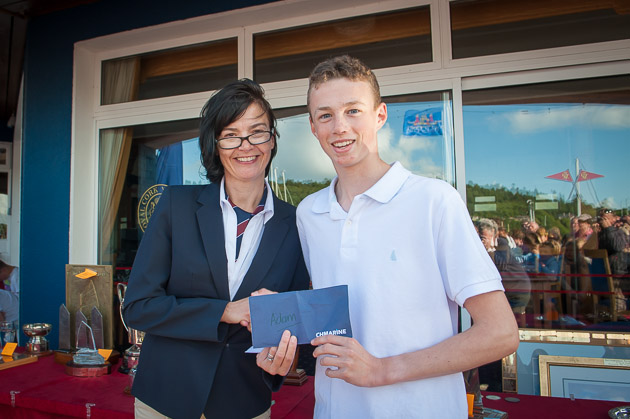
Rear Admiral Dinghies Celine McGrath, making a presentation to Adam D'Arcy in recognition of his Silver Medal win at the International Topper Class World Championships, Pic Robert Bateman
The 2015 Irish Optimist National and Open Championships will take place at Skerries Sailing Club
See Irish Optimist Sailing Gallery by Bob Bateman below. Full Results HERE


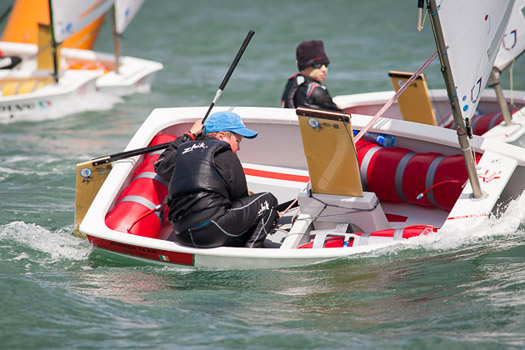


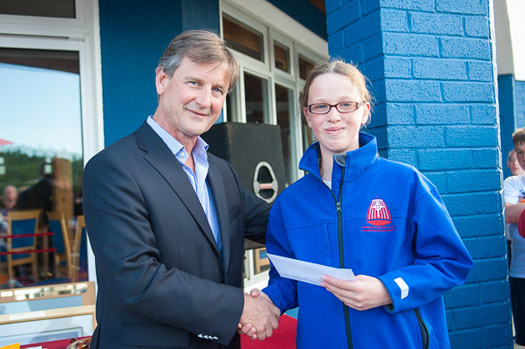
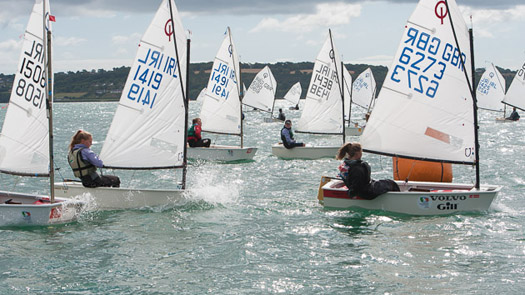
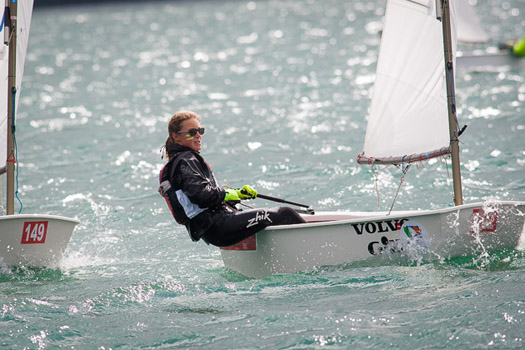
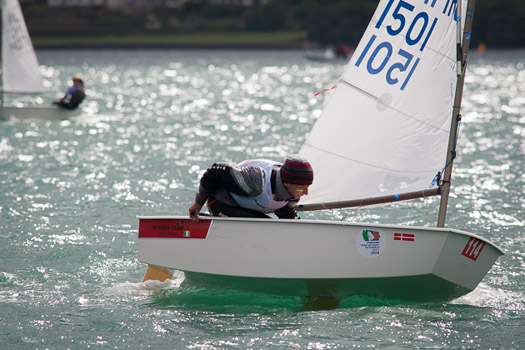

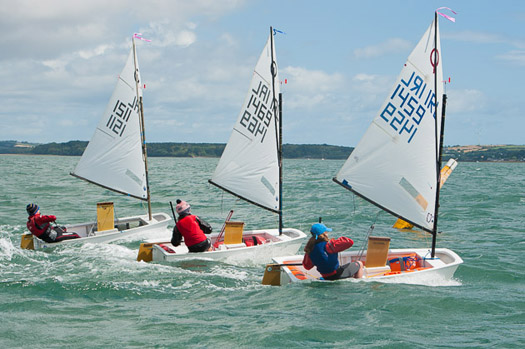
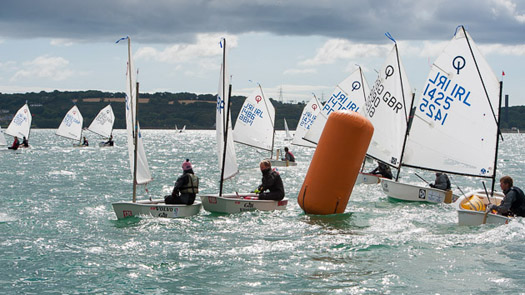
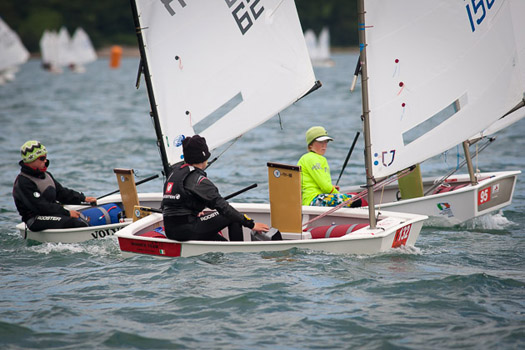

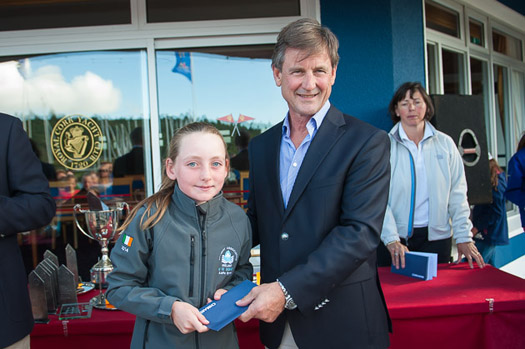
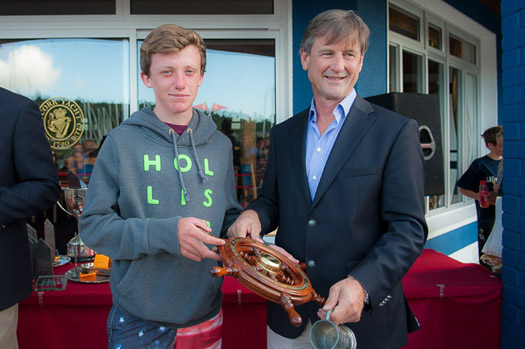
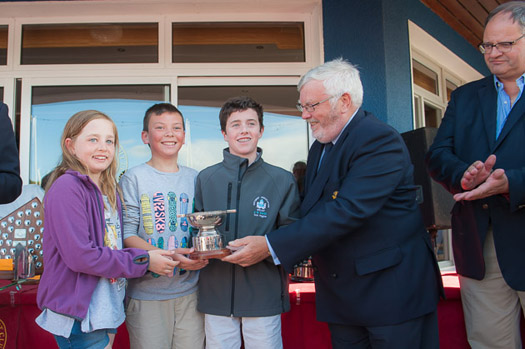
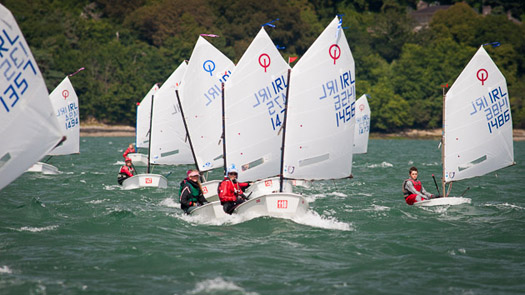

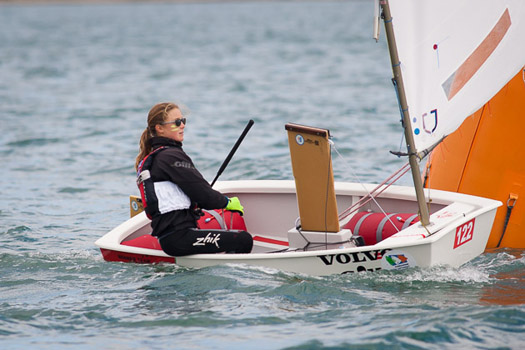

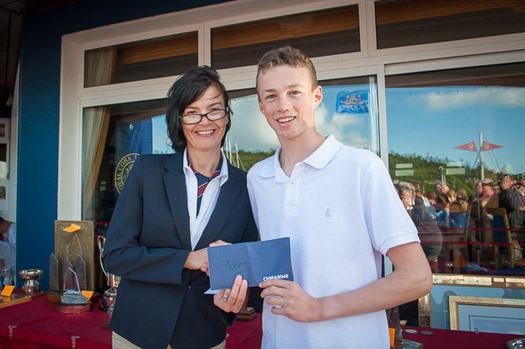
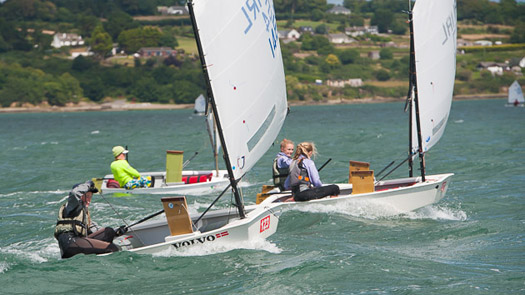
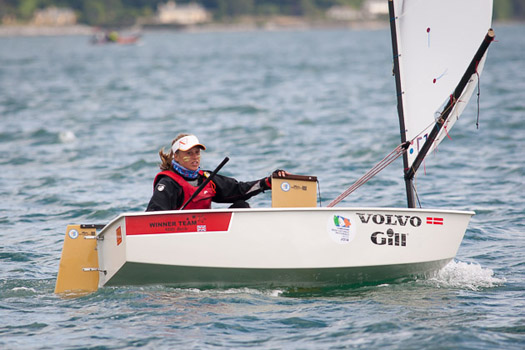


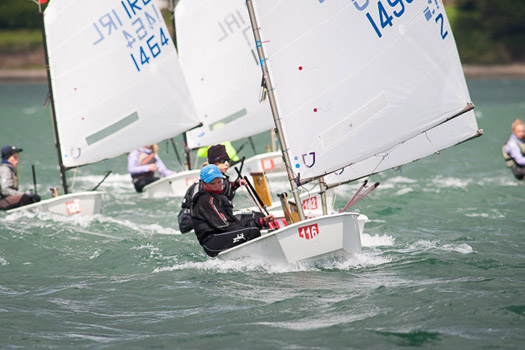
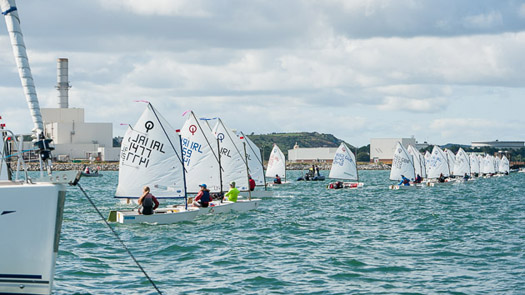

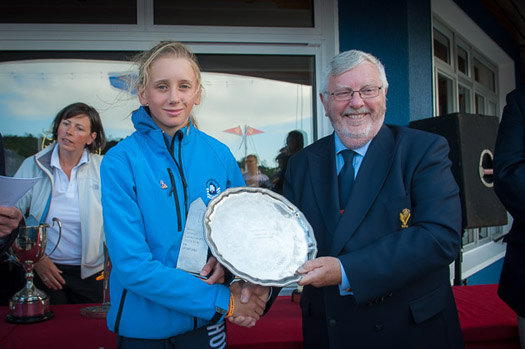


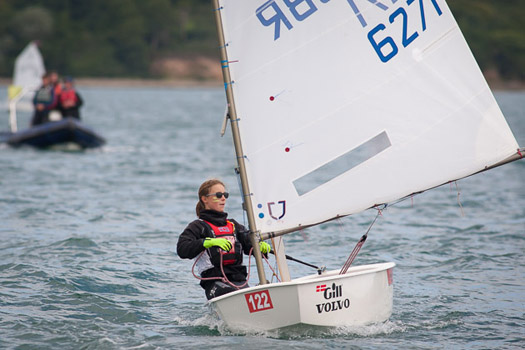
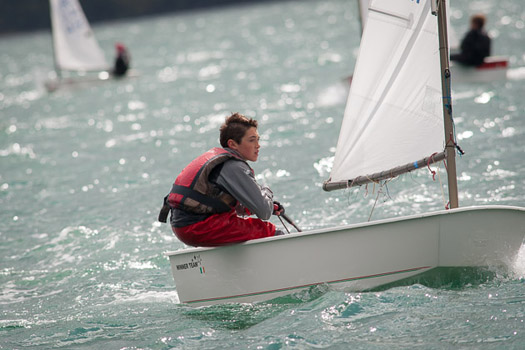


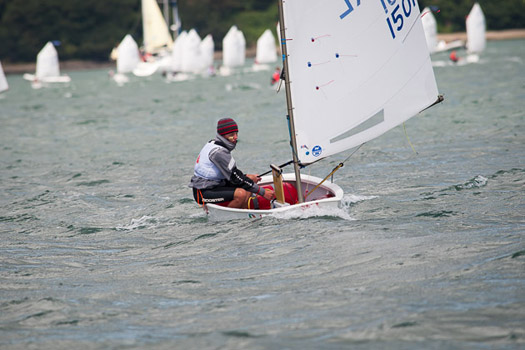
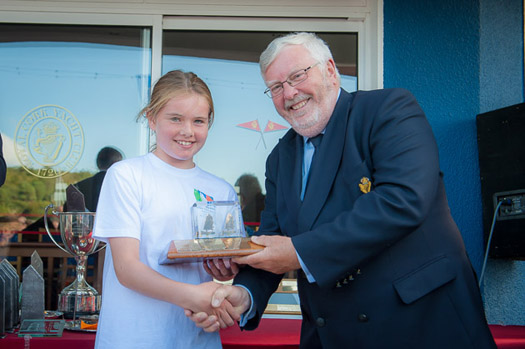
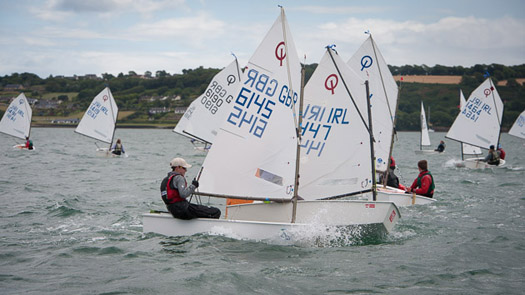

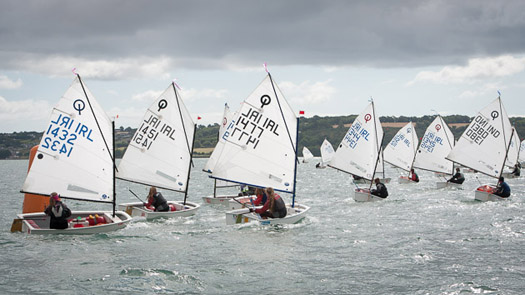


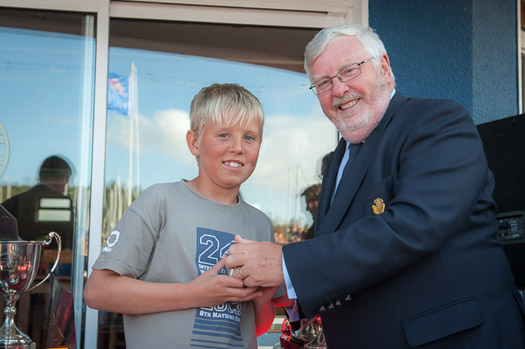
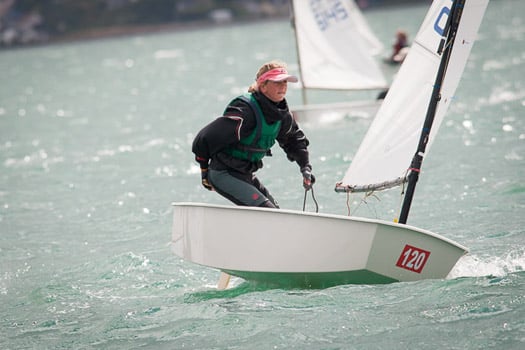
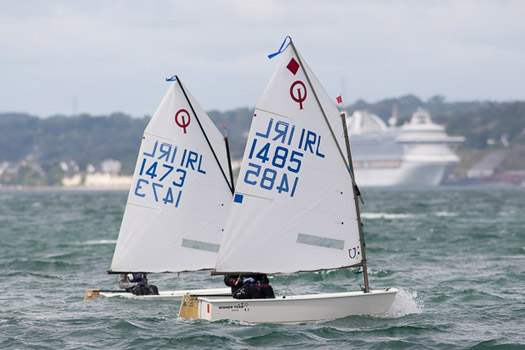
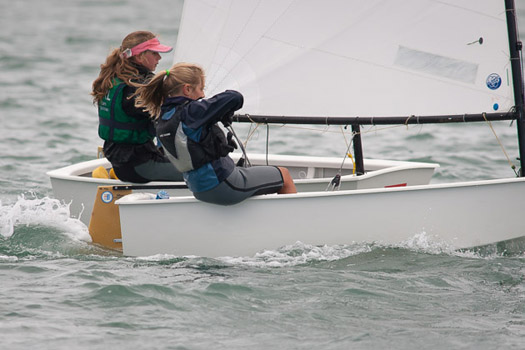
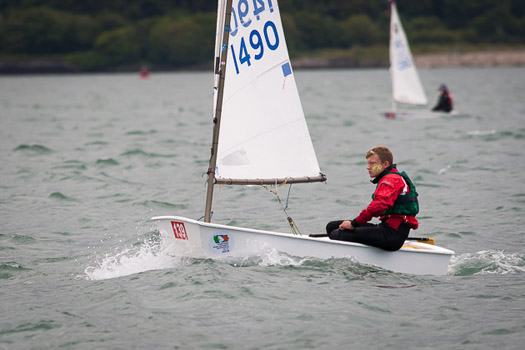
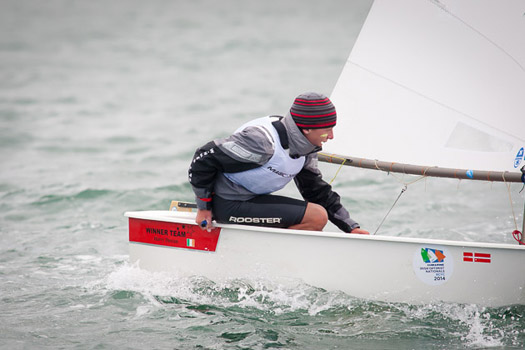
Durcan Counts OCS In First Race of CH Marine Optimist Championships
#optimist – The scene was set at Royal Cork Yacht Club this morning when some 190 competitors took to the water for the first day of racing at the CH Marine Irish Optimist National Championships writes Claire Bateman. The adrenaline fueled young sailors were champing at the bit in their eagerness to get to sea to commence battle. At the launch scene with all the volunteer helpers involved and with the different accents and the varying languages resounding in the morning air, it could have been likened to the tower of babel. The slick preparations and procedures put into place by the host club were well evident and the large number of optimist dinghies took smoothly to the water and on their way to the race area. The Senior and Junior fleets headed to Ringabella with the Regatta fleet younger sailors remaining comfortably closer to home on the Curlane Bank. The beauty of Cork harbour for sailing in any type of weather conditions is well known and the variety of courses available to choose to suit such conditions is second to none.
The weather proved to be in a slightly disobliging mood only providing 6 to 8 knots of a north westerly wind, other times rising to 12 knots and then dying away to 2 or 3. However, Race Officer David O'Brien got the Junior fleet underway followed by the Seniors and Race 1 was duly completed with the shock result of an OCS for Harry Durcan RCYC . However, whilst waiting for Race 2 to follow, the weather mood suddenly changed and the heavens opened with an almost biblical like deluge. This duly passed over and then a change of wind direction forced a relaying of some marks with ensuing delays due to the changeable breeze. Patience persevered and Race 2 finally got under way with an excellent win for Durcan who had suffered an OCS in Race 1. Harry will be our sole Irish Optimist at the forthcoming World Optimist Championship in Buenos Aires.
The Regatta fleet in the safe hands of Race Officer Eddie Rice, sailed on the Curlane Bank and experienced the same deluge before it arrived with the Junior and senior fleets. Racing went very smoothly and it was good to see the smiling faces of the sailors arriving back at the club delighted they had been able to sail two races in spite of the light winds. A tribute indeed to David O'Brien and Eddie Rice with their race teams.
Racing continues tomorrow and hopefully we will see a little more of a steady breeze.
Results here
If you've ever team-raced for "The Book" between Sutton Dinghy Club and a team from Cork Harbour, then you'll know that it is Irish sailing's Book of Kells, inaugurated seventy years ago with the winning team obliged to inscribe the outcome on vellum in illuminated style. W M Nixon found that this year's event last Sunday had the Corkmen celebrating a win, even if they lost the race.
Keeping the records of sporting events may seem the simplest thing in the world, but it's amazing how quickly the written reports can disappear completely. In this blog on 12th April, we were pointing out that ancient sailing trophies are doubly valuable, as they'll still be in existence and lovingly cared for because of their intrinsic worth as pieces of silverware, and with any luck they'll also carry the name of the boats and owners, the early winners of races back in those remote mists of time.
Yet even the world's oldest original sailing trophy, the Ladies Cup of Sligo Yacht Club which dates back to 1822, took a while to cop on to the need to inscribe the names. It didn't occur until 1831, when the winner was Owen Wynne of Hazelwood on Lough Gill, that lovely lake where the Sligomen sailed before they took to the sea at Rosses Point.
Because of this understandable omission – after all, everyone who was anyone in Sligo in the 1820s would have known know who was the current holder of the Ladies Cup – the oldest sailing trophy with a winner inscribed wasn't an annual challenge cup, it was a one off, the Cork Harbour Regatta Cup for 1829. The winner was J Caulfield Beamish with his cutter Little Paddy, which he designed himself. It's a thoughtful experience to contemplate this old trophy, and realize it was once handled by one of the greatest if largely unsung pioneers of Irish sailing.
But beyond the fact of who won, we know little enough of the event in 1829. And as sailing developed down the years, a plethora of events meant that the records became confused, or else there was so much data that nobody took any notice any more.
Enter the International 12ft dinghy, a simple little lugsail rigged clinker-built classic wooden boat. She was designed by George Cockshott of Southport in Lancashire in 1912, and seems to have been an instant success with the approval of the Boat Racing Association, a sort of precursor of ISAF. Fleets sprung up anywhere that sailing took place, though the class soon faded in England where newer designs appeared in the 1920s and '30s. But today, there are thriving groups of International 12s in The Netherlands, Belgium, Italy and Japan, while in Ireland they were quite the thing until 1950.
One good reason for this was that Ireland produced an International 12 superstar, Captain Jimmy Payne of Cork Harbour, who won the World Dinghy Championship racing International 12s in Belgium in 1924, the first time the new Irish Free State had competed in a sailing event in its own right. This meant that the return series for the crews from France, Holland, England, Belgium and Italy came to race against Ireland at the Royal Munster YC in Crosshaven in 1925. This time round it went down to the last race, which Jimmy Payne won by 29 seconds from Bokre of Holland, and his prize was a truly magnificent silver model of an International 12.
The International 12s were also popular around Dublin, particularly on the north side of the Bay where they either sailed from Howth or, when the tide suited, at Sutton Creek. There was only one club on the peninsula at the time, Howth SC, which sent forth an International 12 helmed by Harry McCracken to sail in the Tailteann Games in 1932, and he won the gold medal.
With International 12 sailors of this calibre in both Cork Harbour and around the Howth peninsula, there were links between the two class centres. But it wasn't until 1940 that Sutton Dinghy Club came into being beside the tidal creek. Then in 1944 an inter-club competition was inaugurated in International 12s between SDC and the Cork Harbour Sailing Club, whose young dinghy-oriented sailors with their International 12s included several people who were later to be big achievers in major clubs.
The innovative trophy for the new series was a large vellum book, the pages blank and awaiting inscription. There may well be other inter-club sailing club competitions whose perpetual trophy is an inscribed book containing the record of each annual race, but we don't know of them. Yet the continuing existence of The Book has been so central to a golden thread of sailing in Crosshaven and Sutton that those who have been involved tend to assume that everyone else knows all about it.
The Book (senior version from 1944) and the junior (from 1980) on display at Sutton Dinghy Club for Sunday's 70th Anniversary series. Photo: W M Nixon
Perhaps they do, but this year being the 70th Anniversary, it went slightly more public anyway, with Commodore Andy Johnston and his members at Sutton DC moving mountains to make it happen in a busy season in which, every other year, the race for The Book has to be slotted into a crowded annual programme and the additional need to fit the tidal window for sailing in Sutton Creek.
Over the years, The Book has stayed the same, and it's still the same Sutton Dinghy Club, albeit in larger premises. But Cork Harbour Sailing Club – whose members had been helped in their sailing by Jimmy Payne himself, who also raced for The Book – was wound up in 1950, and its membership largely subsumed into the Royal Munster in Crosshaven, which in turn became the Royal Cork for the Quarter Millennium in 1970.
Over the years, Irish sailing classes which have seen people emerge from the testing and training ground which is the racing for 'The Book' include Olympic boats such as the Flying Dutchman and the Tempest, the famous 505s, many offshore racing fleets, Fireballs, 470s, Lasers, 1720s, SB20s, Etchells 22s, Puppeteer 22s and J/24s, to name only a few. In all, it's an extraordinary list, linked by their connection to sailors from this unique event.
The historic International 12 restored by Aidan Henry of Sutton. Photo: W M Nixon
For many years, The Book was raced for in IDRA 14s, and this restored gem shows off her elegant lines at Sutton. Photo: W M Nixon
As for the gallant little International 12s, they were shunted aside in favour of IDRA14s in 1950. But there was a sweet reminder of the little boats at the 70th anniversary event on Sunday with a beautifully restored version brought back to life by Aidan Henry of Sutton, while also there was a lovingly-maintained and historic IDRA 14. Over the years, classes used have further changed, and for a while all the Cork-based races for The Book were sailed in Enterprises, while a Junior Book inaugurated in 1980 tended to favour Mirrors.
Boats may change and people move on, but The Book has remained as an extraordinary record of personal history and sailing development. The first series in 1944 was well won by Sutton, but over the years the balance has tilted in Cork's favour with 26 wins to Sutton's 18, while there have been two draws and 23 no races resulting from some weekends of total gale and other more grisly reasons - in 1956, it was the polio epidemic.
Grim reminder of times past – the terse entry in The Book for 1956 Photo: Ron Maher
Of that first Cork team of 1944, happily the great Joe Fitzgerald is still with us, and he subsequently sailed on winning teams. As you work your way through the handsome big pages, the names cascade down the years, so much so that just about every sailor of significance from Cork Harbour or Sutton (and sometimes Dublin Bay generally) has been racing for The Book.
The teams and Race Officers at Sutton in 1944 – Joe Fitzgerald of Cork is third from the right in the front row.
Royal Cork won in 1966 with a stellar team
Sutton's Ian Sargent and Royal Cork captain Harold Cudmore with The Book and their teams in 1966
These days, the Sutton sailors favour GP 14s, while for many years now the National 18s have been the heart and soul of Crosshaven sailing. This is so much the case that last year the Crosshaven class produced a fine book by Brian Wolfe not just of its history in Cork Harbour since 1939, but about the story of the National 18 at all its class centres through England, Wales, Scotland, Ireland and the Isle of Man.
Both the GP 14s at Sutton and the National 18s at Crosshaven are having a busy season throughout 2014. But it was noticed that while the cream of the Crosshaven class would be at the British & Irish National 18 Championship in Abersoch in North Wales from July 28th to August 1st, the top GP 14s at Sutton would not be heading away for their Worlds at East Down YC on Strangford Lough until Friday August 8th. There was a tiny window of opportunity on Bank Holiday Sunday, August 3rd, when the paths might be made to cross and the tide suited in late afternoon. So they grabbed it, and Sutton Dinghy Club readied up six evenly-matched GP 14s in a very focused frame of mind, as they hadn't won The Book in sixteen years.
These National 18 sailors from Crosshaven certainly are keen. Despite having raced a gruelling week in Abersoch with the National 18s, Tom Crosbie, Barry O'Meara and Tom Dwyer were ready and willing to race GP 14s for The Book just a day later. Photo: W M Nixon
The two teams for the 70th Anniversary of racing for The Book – Tom Crosbie (left) is Cork captain, while Hugh Gill (centre) captained Sutton. Photo: Ron Maher
At first, conditions looked reasonably promising, but fast moving clouds south and north.............Photo: Andy Johnston
....gave every indication of stronger winds to come. Photo: Andy Johnston
Downsizing from an 18-footer to a 14-footer was gallantly accepted by Cork crew Tom Dwyer and Barry O'Meara. Photo: Andy Johnston
After a week of hard racing off Abersoch, the Corkmen could have been forgiven for wishing only to head on home for a rest, but they're great sportsmen, they were determined to give it their best shot. However, for people down-sizing from a three man 18 footer to a two man 14 footer just for one afternoon's team racing, the conditions were cruel, with a squally west to southwest wind, and a fast-changing sky which promised more to come.
It duly delivered. They managed the first race with the teams even at first, but then Hugh Gill of Sutton sailed Patrick Crosbie of Crosshaven away from his lead over the next Sutton boat, and that changed the table just enough to have Sutton ahead by one point after one race. And that was the end of it. The wind rose well up into the 30 knot zone, there were four capsizes and one dismasting, and The Book for its 70th Anniversary went to Sutton Dinghy Club after a gap of sixteen years.
Tom Crosbie (left) returns The Book to Sutton's Hugh Gill after a 16-year run. But next year's racing will be in Cork in National 18s......Photo: Ron Maher
Yet everyone was delighted with the day. While the team racing tactics may have been cut-throat, the sport was great, and you could have run a string of bright lights off the camaraderie, with Dommo Long, the father of the National 18s, still much involved, although it's a report in The Book from very long ago which records how he kept all Sutton entranced with the post race party until six o'clock in the morning.
The National 18s as they are today. Photo: Bob Bateman
Testing the water. Father of the Class Dommo Long has an approving trial sail on the new National 18 last Autumn. Photo: Bob Bateman
Next year, of course, it will be an away match for the Sutton crews. And who knows, but they may be able to race in the brand new National 18s, a Cork-inspired concept which has been coming along very nicely, and is set to become Ireland's hottest "new" class in 2015, which goes some way to explain why the Cork men arrived in Sutton in such good form.
We ran a story in Afloat.ie about the Phil Morrison-designed prototype sailing at Crosshaven last Autumn, the boat having been cleverly developed through outside sponsorship so the €65,000 development cost didn't make a dent in the class funds. But a prototype is one thing, getting it accepted by the class association and into production is something else altogether, and everything would hinge on how the mood went at the championship in Abersoch, which would also see the crucial AGM.
Afloat, everything went fine for the Corkmen. Stuart Urquhart of the Scottish fleet may have had a good lead in the early stages, but by the finish the 2014 Champion was Ewen Barry of Cork crewed by Dion Barrett and Stan Browne. In runner up place was another Cork helm, Colin Chapman (who has played a leading role in the moves towards the new design), crewed by Bobby Bearla and Morgan O'Sullivan, while initial leader Urquhart was back in third.
The new Odyssey National 18 looks the business for speed..... Photo: Bob Bateman
......and she retains the basic seamanlike features of the established National 18s. Photo: Bob Bateman
The new boat Odyssey was out sailing and showing fabulous performance, so minds were concentrated mightily for the main formal business which came on Thursday July 31st, the 2014 AGM and the acceptance or otherwise of the new design. The National 18 is a restricted class, so in theory any new design which complies with the rules should be accepted. But the days are long gone when cheque-book sailing affected the class – if it ever did – so a significant majority would be needed to be in line with the spirit of the class, which has always favoured design development, but at a measured pace.
The vote was better than a significant majority – it was overwhelmingly in favour. Exciting times lie ahead, and no more so than in Cork. Twelve deposits have already been put down on new boats to the Odyssey design, and eight of those have come from the Cork Harbour fleet.
There's no doubt the new Morrison boat is a gorgeous bit of kit which is a delight to sail, and if you doubt this, I've been told to say that Dommo Long says so. Already, the class is rejuvenating around Cork Harbour, and though there are bound to be growing pains, you need to experience the sheer joy in sailing and the camaraderie of a handsome big three-man boat to understand the extraordinary sense of community which the National 18s engender in the special RCYC context.
In the final analysis, these people are sportsmen who sail for fun, and their dedication and enthusiasm is a joy to behold. They're respectful of the past, yet excited about the future. And the spirit of Jimmy Payne and the International 12s lives on, not least in the fact that the supreme overall prize for the National 18s in Cork Harbour is now the silver International 12 trophy which he won back in 1925.
In 2011, Mrs Eithne Payne presented the International 12 trophy, won by her father-in-law Captain Jimmy Payne in 1925, to RCYC Admiral Peter Deasy to become the season-long overall winner prize for the National 18 Class on Cork Harbour. Photo: Bob Bateman
#sb20 – A competitive fleet is expected for the SB20 National Championship in The Royal Cork Yacht Club this weekend writes Kieron O'Connell.
All the usual suspects will be present in what looks to be a wide open competition with many strong teams travelling to the event. Fresh from their victory in the Northern Championship the Manama crew of Graeme Grant, Ronan Downing and Tara Flood can expect very stiff competition from local sailors Mel and Killian Collins, class newcomer Bob Espey from the RNIYC, previous National Champion and Olympian Peter Kennedy who won the event the last time it was sailed in Cork.
Also expected to be in the mix are Aidan O Connell, and the in form Dinghy Supplies crew of Darragh Sheridan, Shane Murphy and John Phelan from Howth Yacht Club as well as Michael O Connor from Dun Laoghaire. The weather forecast looks good with warm weather and light winds forecast. Race Officer Peter Crowley will have a busy weekend keeping manners on the fleet and getting three races a day.
The Royal Cork Yacht Club have great entertainment planned, there will be live music and a BBQ in the club Friday from 17.30 after racing and on Saturday there will be a live band from 17.30 till late with the event dinner at 19.30.
Venues for the 2015 SB20 season will be discussed at this weekend's national championships at Royal Cork Yacht Club that includes an option of running an event at Greystones Marina Co. Wicklow. A coaching structure for 2015 wil also be put in place
Royal Cork Yacht Club Celebrates ICRA Success On Dublin Bay
#rcyc – Cork sailing prowess was marked at the Irish Cruiser Racing (ICRA) National Championships hosted by the Royal Irish Yacht Club in Dublin last weekend when Royal Cork yachts took both class zero and one to win ICRA's team prize writes Claire Bateman
Denise and Conor Phelan were victorious in Jump Juice Class Zero. Ian Nagle's Jelly Baby won Class One in a very competitive fleet that included J109s, A35's and others. George Kenefick in Nathan Kirwan Trust took second overall in Class Three while Paul Tingle also flew the flag with his Corby 25 Alpaca.
#corkharbour – Camden Fort Meagher, an historic fort in Cork Harbour will headquarter June's International Sailing event for women hosted by Royal Cork Yacht Club it was announced yesterday. An Irish team for the event has yet to be anounced due to late changes in the selection process.
Sixteen international teams are expected to travel and compete and will include some of the world's highest ranking sailors and potential Olympians. Entries to date have been received from New Zealand, United States, Denmark, France and the Netherlands. As Afloat reported earlier the event will also be the first stage of the Women's International match Racing Association tour.
Sponsored by Cork County Council and the Port of Cork, the World Match Racing Championship for Women is one of the world's highest calibre sporting events.
Cork Harbour renowned for its sailing throughout the world, is hosting this event directly under Camden Fort Meagher, which offers unrivalled viewing to competitors, their families, friends, supporters and general public.
Camden Fort Meagher will be the Event Head Quarters for this international sailing event. This will be a first for the fort. Paul Brierley, project coordinator for Camden Fort Meagher said "we are delighted to be part of this world event, which will allow competitors and spectators to enjoy the wonderful ambience of this historic fort and an ariel view of the racing from its spectacular deck". Royal Cork Yacht Club Admiral, Pat Lyons, explains that "Cork and the Royal Cork Yacht Club were chosen over other locations, such as Long Beach California". "This speaks volumes" he said, "of the commitment and expertise we have in the yacht club and in Crosshaven to be chosen to host such a prominent event here in Cork Harbour".
However not all the sailing will take place in the harbour from the 3rd to 8th of June. On 6th of June the River Lee will play host to a one day event, which will bring the international sailing competition into the heart of Cork City for everyone to enjoy.
Cork County Council and the Port of Cork have come together as Joint Title Sponsors to support this prestigious international sailing even. In recent times both Cork County Council and Port of Cork have invested heavily in the harbour area; promoting sailing and other water based activities to aid development of the harbour. Cork's natural harbour is not only a place to do business, but an attractive tourist destination which offers so much to visitors.
Event Chairman, Ronan Enright, comments "We are delighted with the support that has been shown by our sponsors Cork County Council and the Port of Cork. This sponsorship is not only promoting women's sailing, it is also providing a once in a life time experience within the unique setting of Camden Fort Meagher to both competitors and spectators"
Royal Cork's Dinghy PY 500 Regatta Success in Cork Harbour
#rcyc – Weather obliged beautifully for PY 500 making a perfect Sunday morning event at Royal Cork Yacht Club writes Claire Bateman. And what a magnificent spectacle the PY500 (Portsmouth Yardstick) race turned out to be. The sun was shining and there was a Westerly breeze of some 15 knots lightening slowly during the race. The course was Windward/Leeward around laid marks and consisting of seven rounds.
The event consisted of a mixed dinghy race for vessels holding a PY Handicap of 700-1320. Results are downloadable below as a jpeg file.
Due to the thirty one boats participating and the different speeds involved there were officials in position at each mark to record each competitor rounding for each of the seven rounds. Due to the location of the course up and down the river outside the club magnificent spectator viewing was provided for the large numbers present.
There were many boats from different classes represented and they certainly provided spectacular viewing.
The representatives were from National 18s, 505's, RS 400, RS 200, a lone Finn, Fevas, Fireflies, Lasers of all rig types, a Rankin and the star of the show, a 29er that charged around the course showing such style with a fluorescent orange Gennaker. Spotted sailing his RS 200 with his wife Heather was Sean Craig from the RstGYC. Also sailing from the RCYC's own club boats were 2 Topaz, one Magno and one Omega.
In between all this flying action there were Optimsts, 420s and 1720s all setting out for training and all in all there was a tremendous buzz in the club.
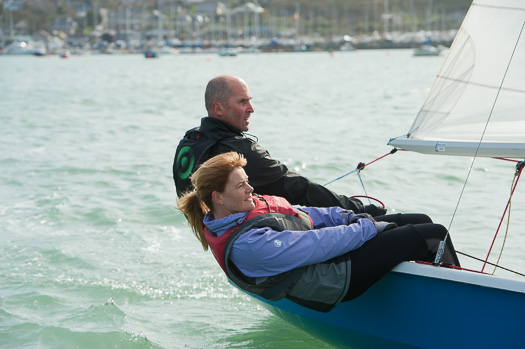
Sean and Heather Craig travelled from Dun Laoghaire for Royal Cork's PY 500. More photos by Bob Bateman below.
It must have made interesting and delightful viewing in the lovely conditions for the members and friends arriving for Sunday lunch at the Club's Globe Restaurant.
All credit due to the organisers and so obviously successful and enjoyable they might consider a repeat performance.
#corkweek – July's Royal Cork Yacht Club's Cork Week regatta will share the same title sponsor as Dun Laoghaire regatta according to this morning's Irish Times Sailing Column. It's a move that gives the Swedish car marque the headline name to both of Ireland's big sailing events. As previously reported by Afloat.ie, the Crosshaven event has had a number of key changes to its format for 2014 aimed at reducing costs for both competitors and organisers alike.
The new sponsorship deal will be a shot in the arm for the biennial event that is Ireland's longest running international regatta, a sporting event that became a global name in the nineties when competitor boat numbers reached 700 in 1998 to rival the UK's Cowes week regatta.
Royal Cork's John Roche is to chair the new week with top Cork helmsman Anthony O'Leary in charge of the famous Cork Week courses.
The J109 fleet will race for national honours as part of the week and a new trophy for short handed competition is also to be introduced. Royal Cork's own 1720 sportboat fleet will also be racing.
The Irish Times has more on the story here.
Match Racing Ireland Keen to See Woman Sailor Who Missed Deadline Invited to Cork Match Race Event
#isaf – Following this morning's news in the Irish Times that the Irish Sailing Association (ISA) has reversed a decision to fill the host nation's wild card place for the ISAF Women's Match Racing World Championship on Cork Harbour in June, Match Racing Ireland has urged organisers to consider the Irish skipper that missed the deadline for an invitation should one become available.
Controversy blew up after the nominations process allowed just eight days and that January 29th deadline expired with just one nomination received, the Irish Times reports.
The four-day event will be held in the J80s at Royal Cork Yacht Club, from June 3rd to 8th. 16 teams of a helm and three crew will be invited to enter as Afloat reported earlier this month.
After protests on the matter, the board of the ISA met on Monday and set aside the process. A sub-committee has been formed to re-open a nomination process and hold trials if necessary.
A statement from Ric Morris of Match Racing Ireland received this morning states:
"Nomination for international representation is the soul responsibility of the ISA. The NOR for the event also makes it clear that the wild card invitations for the event will be decided on by a combination of the ISA and ISAF.
The ISA is under no obligation to but often asks Match Racing Ireland to propose a team and they made contact on the 21st January regarding the ISAF Womens Match Racing World Championships and ISAF Youth Match Racing World Championships.
We agreed to put out a public request for teams to come forward and settled on a date that would allow the OA to issue an invitation to the womens team at the same time as the other competitors. A request, including the deadline, was posted on the ISA website and the Match Racing Ireland Facebook page and Afloat kindly carried the same notice for us.
Two teams had been tracking the events in question and came forward almost immediately with fully formed teams. For the Youth Worlds, Match Racing Ireland has proposed Phil Bandon and we understand that the ISA intends to put him forward for the event.
For the Womens Worlds a team of Royal Cork sailors who have been successfully competing in team racing came forward and where proposed by Match Racing Ireland. The ISA confirmed back to the team that they would inform ISAF and the OA of the proposal.
2 days after the deadline a well known and respected skipper came forward and expressed an interest in doing the event. In fairness to the team that had complied with the original request and given that the skipper them selves acknowledged that they did not have a team in place and had missed the deadline Match Racing Ireland did not feel that it was in a position to change its proposal. How ever, given the experience helm in question, it was suggested that, although they where under no obligation to do so, the proposed team considered combining forces.
If any of the invitations issue by the OA are declined they have the discretion to issue an invite as they see fit. Match Racing Ireland has made it clear to the ISA, ISAF and OA that they would be very keen for the skipper that missed the deadline to get an invitation should one become available.
We've had no further involvement in this matter"
'Pledge Your Commitment' – New Royal Cork Admiral Urges Members to Support Club in 2014
#royalcork – The Annual General Meeting of the Royal Cork Yacht Club took place last night and attracted a capacity attendance writes Claire Bateman. Outgoing Admiral Peter Deasy and his team took the meeting through the business of 2013 before handing over to the incoming Admiral, Pat Lyons and his team.
Admiral Pat Lyons then paid tribute to the work of the former Admiral and said " at this time it would be remiss of me not to acknowledge the work done by the 2012-13 Executive Committee, so ably led by Peter Deasy. I want to thank him for giving me the opportunity to serve as his Vice-Admiral and for proposing me as Admiral, and I would ask you all to join with me in thanking him and all of the outgoing Executive for their hard work during the past two years."
Over time, Members have encouraged the hosting of major events within our Club and the 2014 season will witness a response the these demands. For 2014, we host three major events. These are:
The prestigious ISAF Women's Worlds Match Racing Championships, which take place in the first week of June Cork Week, which commences on Monday, July 7th, and The Irish Optimist National Championships, which will be held during the third week of August, and which promises to bring significant numbers of junior sailors and their families to our Club
The success of such major events is dependent to a significant on voluntary effort and I encourage all Members to become involved in facilitating and supporting these events, so as to showcase the well earned reputation of Royal Cork as a location for major national and international sailing events.
Looking farther into the future, during 2013, former Admiral Deasy commenced a process of addressing the Club's 300th Anniversary, which takes place in just six year's time, in 2020. To date, several informal meetings have taken place with a small number of members aimed at capturing a range of ideas relevant to celebrating and marking this unique and auspicious event. It is my plan to formalise and accelerate this process over the coming months and we will be inviting widespread participation from across all sectors of the membership base in this process.
The success of such major events is dependent to a significant on voluntary effort and I encourage all Members to become involved in facilitating and supporting these events, so as to showcase the well earned reputation of Royal Cork as a location for major national and international sailing events."
The Admiral then spoke on issues of membership and other related matter and outlined his ideas for same that would be further discussed with his Executive team.
Concluding his address I quote "As I said at the beginning, these are challenging times for our Club, but they are also exciting times. And as we begin to emerge from the past few difficult years, it is my hope that we can look forward to an exciting future. Doing so will require work, effort and perseverance. Not just by the members of the Executive and the designated Sub-committees and staff who work so hard on our behalf, but by you the Members.
As a Club, our strength is drawn from its Members, from their commitment, their loyalty and their support.
For 2014, can I urge you to pledge your own commitment and support to the Club of which we are all justifiably proud? It is through your support, commitment and loyalty that its continued future will be delivered. "





























